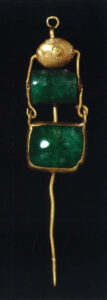 Our cultural heritage comprises many art objects that are hundreds, some thousands of years old. How did they survive this long? While many factors determine if and how art can be preserved, one has fundamentally impacted its long-term survival: the desire to make and own artefacts that withstand the test of time. My current research project on the history of durability in art will undertake the first comprehensive study of the impact of the artisan and patron’s ambitions to craft, own and theorize durable objects on the long-term development of the visual and decorative arts. To achieve durability, artisans have worked stone and metal, created dyes and pigments thought never to fade, made surface coatings ensuring the protection of more brittle materials, and transformed soft clay into long-lasting ceramics. Patrons coveted physically stable objects; yet stability does not always ensure durability: culturally fragile gold can be melted and re-used. Beyond how the durable was made, DURARE will map the social practices influencing durability. We will also establish how, through artistic and social pursuits for durable art, humans acquired knowledge of the stability and behavior of materials over time, thus impacting knowledge traditions outside art history. Finally, we will elucidate the created practices and institutions facilitating durability, such as cultural heritage conservation and museums.
Our cultural heritage comprises many art objects that are hundreds, some thousands of years old. How did they survive this long? While many factors determine if and how art can be preserved, one has fundamentally impacted its long-term survival: the desire to make and own artefacts that withstand the test of time. My current research project on the history of durability in art will undertake the first comprehensive study of the impact of the artisan and patron’s ambitions to craft, own and theorize durable objects on the long-term development of the visual and decorative arts. To achieve durability, artisans have worked stone and metal, created dyes and pigments thought never to fade, made surface coatings ensuring the protection of more brittle materials, and transformed soft clay into long-lasting ceramics. Patrons coveted physically stable objects; yet stability does not always ensure durability: culturally fragile gold can be melted and re-used. Beyond how the durable was made, DURARE will map the social practices influencing durability. We will also establish how, through artistic and social pursuits for durable art, humans acquired knowledge of the stability and behavior of materials over time, thus impacting knowledge traditions outside art history. Finally, we will elucidate the created practices and institutions facilitating durability, such as cultural heritage conservation and museums.
Marjolijn Bol’s research interests focus on the interdependence of the history of art with the history of materials, techniques and knowledge. She gained her PhD thesis in art history at Utrecht University: Oil and the Translucent: Varnishing and glazing in practice, recipes and historiography, 1100-1600 (2012). Her study shows how the history of the discovery and use of the transparent properties of oil as varnish and paint medium is central to understand the roots of medieval panel painting in imitative practices and, from the fifteenth century onwards, its emancipation as liberal art. While grounded in art history, Marjolijn’s research interacts with historical studies of craft, technology, science and social studies. Special to her approach is the making of historical reconstructions to investigate the appearance of materials or objects that only came down to us in writing (i.e. recipes) or survived in poor condition.

